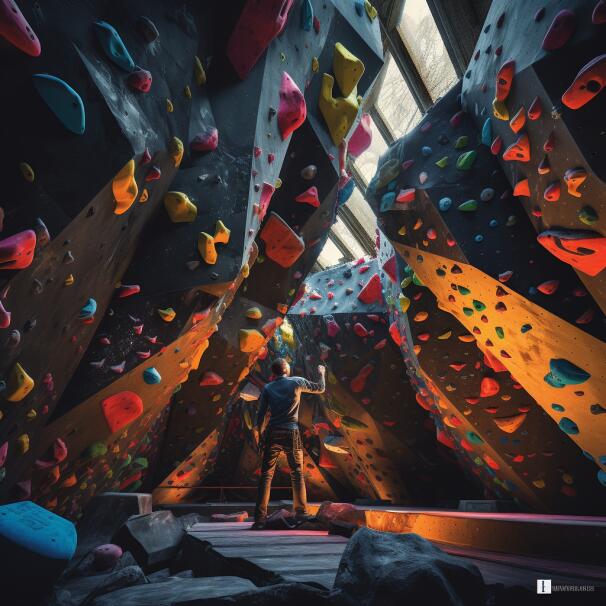
Table of contents
• Introduction
• Essential Gear for Bouldering
• Technique Tips for Bouldering
• Training for Bouldering
• Etiquettes to Follow while Bouldering
• Pushing Your Limits in Bouldering
• Conclusion
Introduction
Welcome, aspiring boulderer! Whether you're new to the sport or looking to improve, this guide will give you the essential tips to successfully step up your bouldering game.
What is bouldering, you ask? It's a style of rock climbing that's done without ropes or harnesses - just you, the boulder, and your strength. It's become increasingly popular in recent years due to its accessibility and lower risk compared to other forms of climbing. Plus, it's a great full-body workout that challenges both your physical and mental strength.
But the benefits of bouldering go beyond just fitness. It's a community-oriented sport that encourages teamwork, problem-solving, and perseverance. And let's not forget the satisfaction of finally completing a route that you've been working on for weeks (or months)!
Now that you know the basics, let's dive into the gear, technique, training, and etiquette that will take your bouldering skills to the next level. And remember: it's not about being the strongest or the best. It's about pushing your limits and having fun along the way. Let's get started!
Essential Gear for Bouldering
The right gear can make a huge difference when it comes to bouldering. Make sure you have the following items in your gear bag before hitting the boulder field:
Climbing Shoes - Invest in a pair of climbing shoes that fit your feet well and provide good traction on the rock. Finding the right shoe is key to improving your bouldering technique.
Chalk Bag and Chalk - Keep your hands dry and grippy with a chalk bag and chalk. Trust us, you don't want to miss a hold because of sweaty palms!
Crash Pad - A good crash pad is essential to protect yourself in case of a fall. Look for ones with a thick foam padding and durable material. Your body will thank you.
Climbing Brush - A climbing brush is another essential item to keep in your gear bag. Use it to clean off any dirt or chalk buildup on holds to ensure a better grip.
Now that you have your gear sorted, it's time to work on your technique and training to take your bouldering skills to the next level.
Technique Tips for Bouldering
Bouldering can be a physically demanding sport, but technique plays a crucial role in your success.
Focus on footwork: Your feet should be doing most of the work while your arms merely keep you on the wall.
Use an open-hand grip: Save your forearm strength by using an open-hand grip instead of clinging to holds with a death grip.
Learn to dyno: A dyno involves jumping between holds that are too far apart to reach statically.
Experiment with body positioning: Sometimes, shifting your hips a few inches can make a big difference in reaching the next hold. Keep in mind that mastering these techniques takes time and patience.
Training for Bouldering
When it comes to training for bouldering, there are a few key areas to focus on. Firstly, core strength is essential for stabilizing the body and maintaining balance while on the wall. Target your core through exercises such as planks, sit-ups, and leg lifts.
Secondly, finger strength is crucial for gripping holds and improving endurance. Focus on exercises such as finger hangs, campus board training, and grip strengtheners.
Thirdly, climbing endurance is essential for tackling longer climbs and preventing fatigue. Incorporate cardio and interval training into your routine to improve endurance and increase your climbing stamina.
Lastly, consider trying climbing-specific yoga to improve flexibility, balance, and mental focus. These workouts can help you reduce the risk of injury and develop a consistent practice that supports your climbing goals. Don't forget to stretch regularly to improve your mobility and prevent injury.
Etiquettes to Follow while Bouldering
While bouldering can be a fun and exciting activity, it's important to remember to be courteous and follow a few basic rules of etiquette.
Always respect the climbing gym rules, including any posted regulations regarding bouldering. Avoid spraying beta, as giving unsolicited advice can be seen as presumptuous (and annoying). Don't hog a boulder; be mindful of others waiting to climb.
Finally, clean up after yourself, including your gear and any debris created during your climb. Remember, a little courtesy goes a long way!
Pushing Your Limits in Bouldering
Want to take your bouldering skills to the next level? Start by setting a goal. Think of a route that you tried and failed before, and work towards completing it.
Trying harder climbs challenges your problem-solving skills, helping you improve your technique. Additionally, finding a climbing partner or joining a bouldering community can be a great way to learn from others, gain support, and share your progress.
And if you really want to test your skills, consider participating in bouldering competitions. They provide a fun and competitive environment, giving you the opportunity to compare your abilities with other climbers.
Remember, pushing yourself to improve is what bouldering is all about. So, what are you waiting for? Start setting those goals, and aim high!
Conclusion
Bouldering is an addictive sport that can bring immense joy and satisfaction. It challenges your physical and mental strength, and helps you push your limits. Keep bouldering to reap its many benefits and experience the thrill of conquering challenging routes. Remember to set goals, find a partner, and explore competitions to step up your bouldering skills. Final Thoughts: Challenge yourself, stay focused, and have fun!

